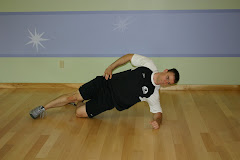
To breathe or not to breathe, that is the question!
Actually the question is "when" to breathe or "how" to breathe. The standard recommendation is to inhale during the eccentric phase (EP) of the repetition and exhale during the concentric phase (CP) of the repetition. Not bad general advice, but when you are working with a beginner just getting them to inhale and exhale during strength training is a victory, period.
Making sure that one does not hold their breath, especially during maximal lifts, is critical. There may be some benefits to inhaling during the eccentric phase (EP) of a repetition and exhaling during the concentric phase (CP) during strength training, but I believe you have to address this before you put a weight in some one's hand.
I often times begin with a "breathing test" to assess function of inspiration and expiration.

Short 1 minute 32 second video of a breathing test here...
(WOW! What a goofy still shot! lol)
I teach clients the importance of proper breathing patterns (more on this another time but activation of deep intrinsic stabilizers and relaxation of global musculature) and the drawing in maneuver.
NOT THE VACUUM POSE!

You can get fancy with alternating nostril breathing techniques and such..

..which is great, it just depends how thorough you want to be.
Just enough to get this to happen...

...and get these working together

Negative impact of not breathing? Well, yes, death...

...but increased arterial pressure (good old valsalva!) is a significant concern among the general fitness client and even amongst elite level power lifters and Olympic weightlifters performing max efforts lifts. So breathing consistently and comfortably are hugely important but the inhale on the EP and exhale on the CP may actually provide a better mechanical platform for us to produce force from and keep our spine and accessory structures (from discs to ribs).*for more on this see Chaitow and McConnell below...
We know that if we do not provide the necessary oxygen to working muscles, their performance will suffer. We also know that specific muscles can be conditioned...or deconditioned...so a deconditioned diaphragm may rob oxygen (Robin Hood Effect) from the larger muscles during athletic activity and negatively impact performance.
Breathing can be complicated when you peel back the layers.
I learned about four different types of breathing from Scott Sonnan
1) Normal volume(clavicular)-talking volume
2) Complementary volume (intercostal)-medium intensity exercise breathing
3) Supplementary volume (diaphragmatic)-high intensity level exhales
4) Residual (reserve)-which we have unless a lung is punctured or we expire
So..learn to breathe, learn to breathe while activating the core stabilizers and then learn to inhale during he Eccentric Phase and exhale during the Concentric Phase.
For some more reading on breathing...
By Leon Chaitow from Massage and Body Work Magazine. Click the link below
http://leonchaitow.com/PDFs/UnderstandingBreathing_MNB_JJ_07.pdf
More from Chaitow on breathing and back pain
http://leonchaitow.com/PDFs/pdfBackPainAndBreathing.pdf
Alison K McConnell, BSc, MSc, PhD, FACSM has a great piece on breathing and performance if you want to sink your teeth into something.
http://www.concept2.co.uk/training/breathing.php
Harms et al's work "Effects of Respiratory Work on Exercise Performance" is worth the once over as well.
There are many other experts to read to deepen your understanding of a complex but seemingly simple subject, but I hope this helps!
Thanks for reading and watching!
Eric Beard
Athletic Performance Enhancement Specialist
Corrective Exercise Specialist
theericbeard.blogspot.com
www.ericbeard.com





